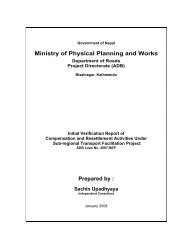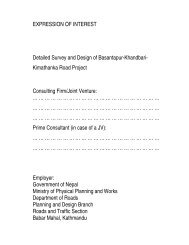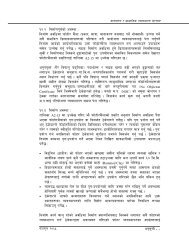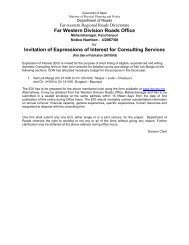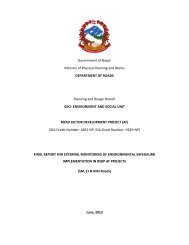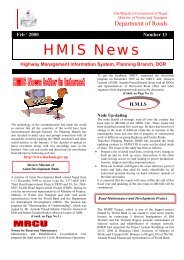Environmental & Social Management Framework - About ...
Environmental & Social Management Framework - About ...
Environmental & Social Management Framework - About ...
You also want an ePaper? Increase the reach of your titles
YUMPU automatically turns print PDFs into web optimized ePapers that Google loves.
<strong>Environmental</strong> and <strong>Social</strong> <strong>Management</strong> <strong>Framework</strong>environmental and social safeguard aspects, and how to avoid adverseimpacts and how to enhance beneficial ones. In this context, specialreference is made to a supplementary report referring to ‘Lessons ofExperience – Case Studies of Complemented Projects’ prepared andsubmitted in Sept. 2006 by the Consultants, as well as to the ‘ProjectCompletion Report for RMDP, prepared by SMED/CEMAT in June 2005.• Assist the GESU of DoR in the preparation of IEEs, EIAs and SIAs to beused as standard operational assessment and management models forfuture sub-projects becoming selected under the SRN road program.• Prepare an exemplary matrix of mitigation measures to manage the identifiedimpacts.• Identify practical, feasible, credible and cost effective measures to offset or toreduce adverse environmental and social impacts to acceptable level, andways to enhance positive impacts. As applicable, also address secondary,induced and cumulative impacts that may be associated with the forthcomingroad construction activities.• Make specific reference to the public consultation process and theconsultation framework, describing adequate participatory mechanismsparticularly with respect to local employment, gender issues, empowermentand local control instruments.• Prepare a Resettlement Policy <strong>Framework</strong>.• Prepare a Vulnerable Community Development <strong>Framework</strong>.• Recommend measures to strengthen project implementation mechanismsand institutional arrangements at different phases of the project cycles, withrespect to the <strong>Environmental</strong> and <strong>Social</strong>/ Resettlement <strong>Management</strong> Plans.• Provide a detailed account on strengthening the institutional capacity of DoR,in specific of the unit in charge, the GESU. Based on a need assessment(Chapter 10) This should be followed by a an in-house training program onenvironmental and social impact assessment skill development. 31.3.2 Methods Applied to Prepare the ESMFThe methodology adopted for preparation of the ESMF included:Review of relevant GoN environmental and land acquisition legislation andoperational guidelines;(i) Review of pertaining operational guidelines from various donor agencies(WB, ADB, JICA, DFID) being actively involved in the country’s road andtransport sector programs 4 ;(ii) Consultation of meteorological, hydrological, and geological sourceinformation (atlases, thematic maps, scientific data compilation, statisticalmaterial etc.) for the said regions;(iii) Site-specific E&S assessments, collecting environmental and socialbaseline data for sub-projects selected by the Client;(iv) Identification of stakeholders and carry out public consultation at selectedsites on environmental and social issues 5 ;3 Prepared and submitted by the Consultants in a separate document.4 Key documents included the Land Acquisition Act (1977) and the World Bank’s OperationalPolicy 4.12 on Involuntary Resettlement and Operational Directive 4.20 on Indigenous Peoples5 Carried out in randomly selected sample subprojects in the Terai and Hill Districts. Details seethe social impact assessment reports of the PIP Consultations were held with differentstakeholders, including VDCs, DDC’s, Local Road User Groups (LRUG), local NGOs, as wellas other government departments. Separate interviews were held with vulnerable groups,women, disabled and landless.Chapter 1-4 April 2007


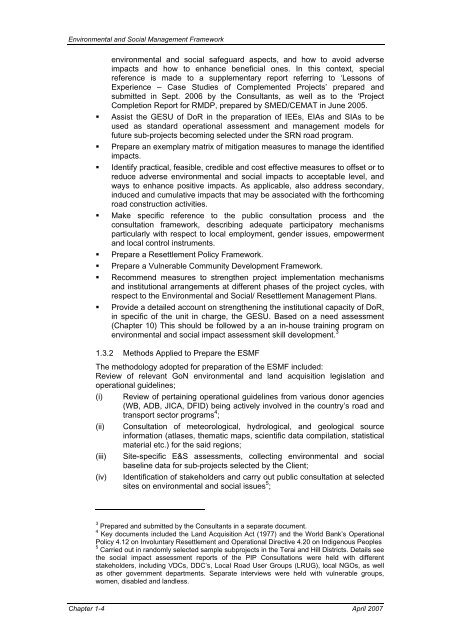
![j:6 ]zg cfof ]hgf](https://img.yumpu.com/51286794/1/190x245/j6-zg-cfof-hgf.jpg?quality=85)

![x'nfsL /fhdfu { cfof ]hgf](https://img.yumpu.com/50581959/1/190x245/xnfsl-fhdfu-cfof-hgf.jpg?quality=85)
